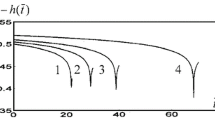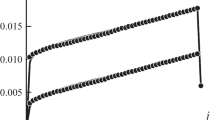We have established a connection between fracture and strengthening of fiber-reinforced composites and the fundamental concepts of time, space, and order. We have identified and considered in detail two types of processes in composites loaded by external forces. For processes of the first type, we have obtained formulas interrelating the initial and final degree of order/disorder, the relative scale, and the time of existence of the system. For processes of the second type, we have obtained a formula for estimating the instantaneous degree of order/disorder as a function of time, the initial and the equilibrium degree of order/disorder, and the relaxation time of the system. We have considered simultaneous occurrence of processes of the first and second type. Experiments on composites have confirmed the connection between the kinetics of processes of the first and second type and the fundamental concepts of time, space, and order.





Similar content being viewed by others
References
A. V. Motavkin and V. F. Skorodumov, Khim. Volokna, No. 1, 23-32 (2016).
A. V. Motavkin and V. F. Skorodumov, Khim. Volokna, No. 3, 26-36 (2014).
E. M. Pokrovskii and A. V. Motavkin, Vysokomol. Soedin. A, 38, No. 6, 980-988 (1996).
A. V. Motavkin, V. F. Skorodumov, and E. M. Pokrovskii, Vysokomol. Soedin. A, 44, No. 12, 2179-2188 (2002).
A. V. Motavkin and E. M. Pokrovskii, Vysokomol. Soedin. A, 44, No. 1, 78-84 (2002).
V. I. Al’perin, N. V. Korol’kov et al., Structural Fiberglass-Reinforced Plastics [in Russian], Khimiya, Moscow (1979). 360 pp.
S. A. Saltykov, Stereometric Metallography [in Russian], Metallurgiya, Moscow (1970). 375 pp.
E. M. Pokrovskii and A. V. Motavkin, Vysokomol. Soedin. A, 39, No. 12, 2017-2030 (1997).
I. Prigogine, From Being to Becoming: Time and Complexity in the Physical Sciences [Russian translation], Nauka, Moscow (1985). 328 pp.
V. V. Nalimov, In Search of Other Meanings [in Russian], Tsentr Gumanitarnykh Issledovanii [Center for Humanities Studies], Moscow/St. Petersburg (2013). 460 pp.
Author information
Authors and Affiliations
Corresponding author
Additional information
A. V. Motavkin is Deceased.
Translated from Khimicheskie Volokna, Vol. 48, No. 5, pp. 29-41, September-October, 2016.
Appendices
Appendix 1
with two unknowns \( \left\langle {p}_{\widehat{t}}\right\rangle \) and \( \left\langle {q}_2^{\ast}\right\rangle \) . From the first equation for the specified initial conditions, we can easily find that \( \left\langle {q}_2^{\ast}\right\rangle \) – \( \left\langle {p}_{\widehat{t}}\right\rangle \) = c = const, from which we have \( \left\langle {q}_2^{\ast}\right\rangle \) = c + \( \left\langle {p}_{\widehat{t}}\right\rangle \) . Here 1/τ is in fractions of \( {\overline{t}}^{\ast }=\left(\left\langle {q}_0\right\rangle /{q}_1^{\ast}\right)\overline{m} \), while \( \left\langle {q}_1^{\ast}\right\rangle \) = c (for \( \left\langle {p}_{\widehat{t}}\right\rangle \) = 0). As a result, we obtain one implicit Eq. (16) (Appendix 1) with only one unknown \( \left\langle {p}_{\widehat{t}}\right\rangle \):
Appendix 2
Appendix 3
Appendix 4
Here we take into account that
-
a)
clusters of the second type occupy only a fraction γ [2] of the area unoccupied by clusters of the first type;
-
b)
since the values of \( {l}_0^{\ast } \) and \( {d}_0^{\ast } \) are approximately proportional to the length of the reinforcing fibers, their ratio \( {l}_0^{\ast }/{d}_0^{\ast } \) ≈ 5 [2].
Appendix 5
Rights and permissions
About this article
Cite this article
Motavkin, A.V., Skorodumov, V.F. Connection Between Fracture and Strengthening of Fiber-Reinforced Composites and the Fundamental Concepts of Time, Space, and Order. Fibre Chem 48, 384–397 (2017). https://doi.org/10.1007/s10692-017-9803-0
Published:
Issue Date:
DOI: https://doi.org/10.1007/s10692-017-9803-0




